jump start MERCEDES-BENZ E-CLASS CABRIOLET 2010 Owners Manual
[x] Cancel search | Manufacturer: MERCEDES-BENZ, Model Year: 2010, Model line: E-CLASS CABRIOLET, Model: MERCEDES-BENZ E-CLASS CABRIOLET 2010Pages: 333, PDF Size: 7.64 MB
Page 8 of 333
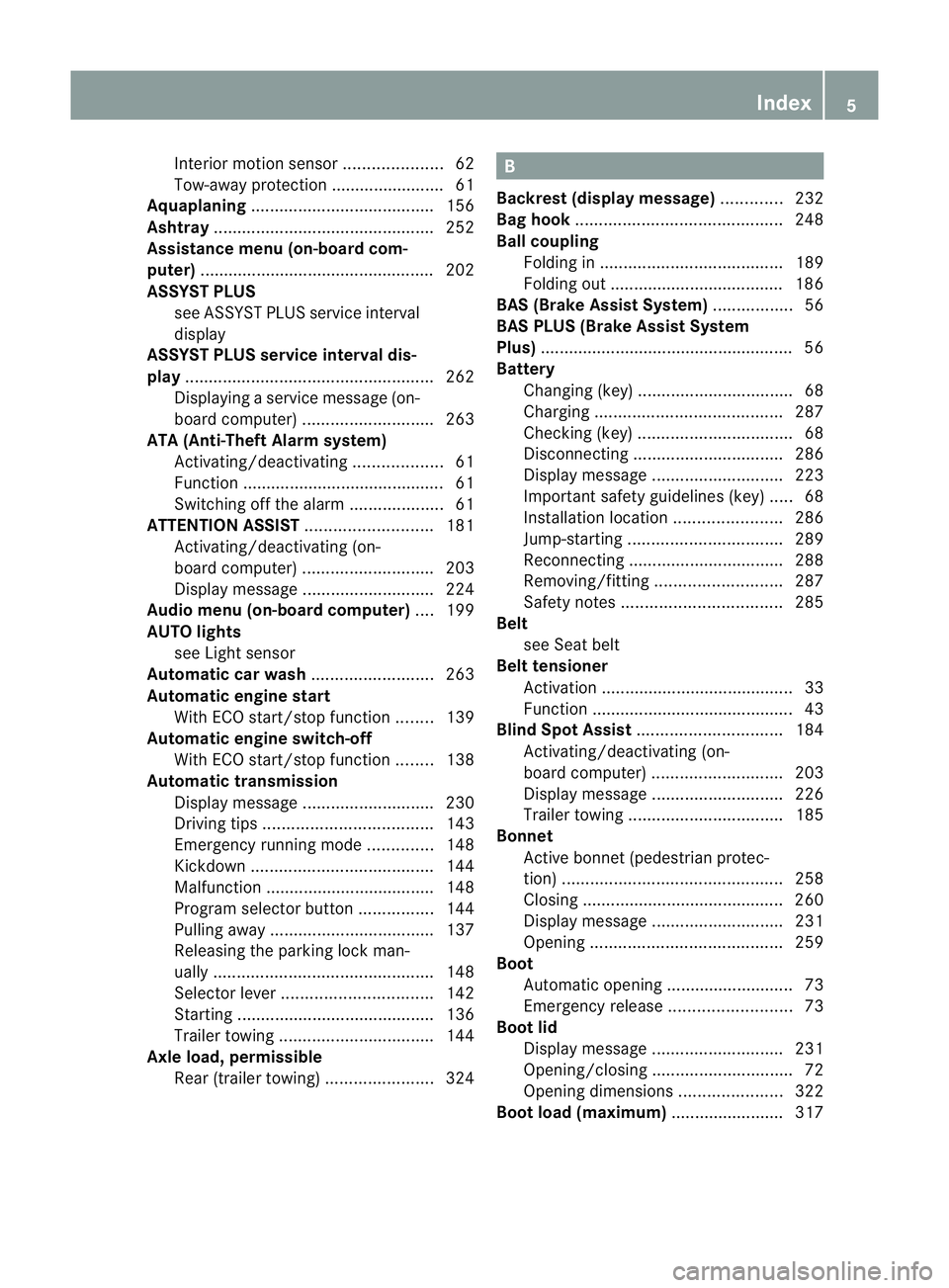
Interio
rmotion sensor ..................... 62
To w-awa yprotectio n........................ 61
Aquaplaning ....................................... 156
Ashtray ............................................... 252
Assistanc emenu (on-board com-
puter) ................................................. .202
AS SYST PLUS
see ASSYS TPLUS service interval
di sp lay
ASSYST PLU Sservice interval dis-
play ..................................................... 262
Displaying aservice message (on-
board computer) ............................ 263
ATA (Anti-Theft Alarm system)
Activating/deactivating ...................61
Functio n.......................................... .61
Switchin goff th ealarm .................... 61
ATTENTIO NASSIST ........................... 181
Activating/deactivating (on-
bo ardc omputer )............................ 203
Display message ............................ 224
Audio men u(on-boa rd computer) ....199
AUT Olights
see Light sensor
Automatic car wash ..........................263
Automatic en gine start
With ECO start/stop function ........139
Automatic en gine switch-off
With ECO start/stop function ........138
Automatic transmission
Display message ............................ 230
Driving tip s.................................... 143
Emergency running mod e.............. 148
Kickdow n....................................... 144
Ma lfunction ...... ............................. .148
Progra mselecto rbutton ................ 144
Pullin gaway................................... 137
Releasing the parking lock man-
ually ............................................... 148
Sel ector leve r................................ 142
Starting .......................................... 136
Traile rtowing ................................. 144
Ax leload, permissible
Rea r(trai lert owing) ....................... 324 B
Backre st(display message) .............232
Bag hook ............................................ 248
Ball coupli ng
Folding in ....................................... 189
Fol ding out ..................................... 186
BAS (Brake Assist System) .................56
BAS PL US(Brak eAssist System
Plus) ...................................................... 56
Battery Changing (key )................................. 68
Ch arging ........................................ 287
Ch ecking (key )................................. 68
Disconnecting ................................ 286
Display message ............................ 223
Important safety gu idelines (key) .....68
Installati on location....................... 286
Jump-starting ................................. 289
Rec onnecting ................................. 288
Removing/fittin g........................... 287
Safety notes .................................. 285
Belt
seeS eat belt
Belt tensioner
Activation ...... ................................... 33
Functio n.......................................... .43
Blind Spo tAssist ............................... 184
Activating/deactivating (on-
bo ardc omputer )............................ 203
Display message ............................ 226
Traile rtowing ................................. 185
Bon net
Active bonne t(pedestrian protec-
tion) ............................................... 258
Closing ........................................... 260
Display message ............................ 231
Opening ......................................... 259
Boot
Automatic op ening ........................... 73
Emergency releas e.......................... 73
Boo tlid
Display message ............................ 231
Opening/closing .............................. 72
Opening dimensions ......................322
Boo tload (maximum) ........................ 317 Index
5 BA 207 ECE ÄJ 2010/1a; 1; 2, en-GB
mkalafa
Version: 3.0.2.11 2010-01-26T13:03:22+01:00-Seite 5
Page 13 of 333
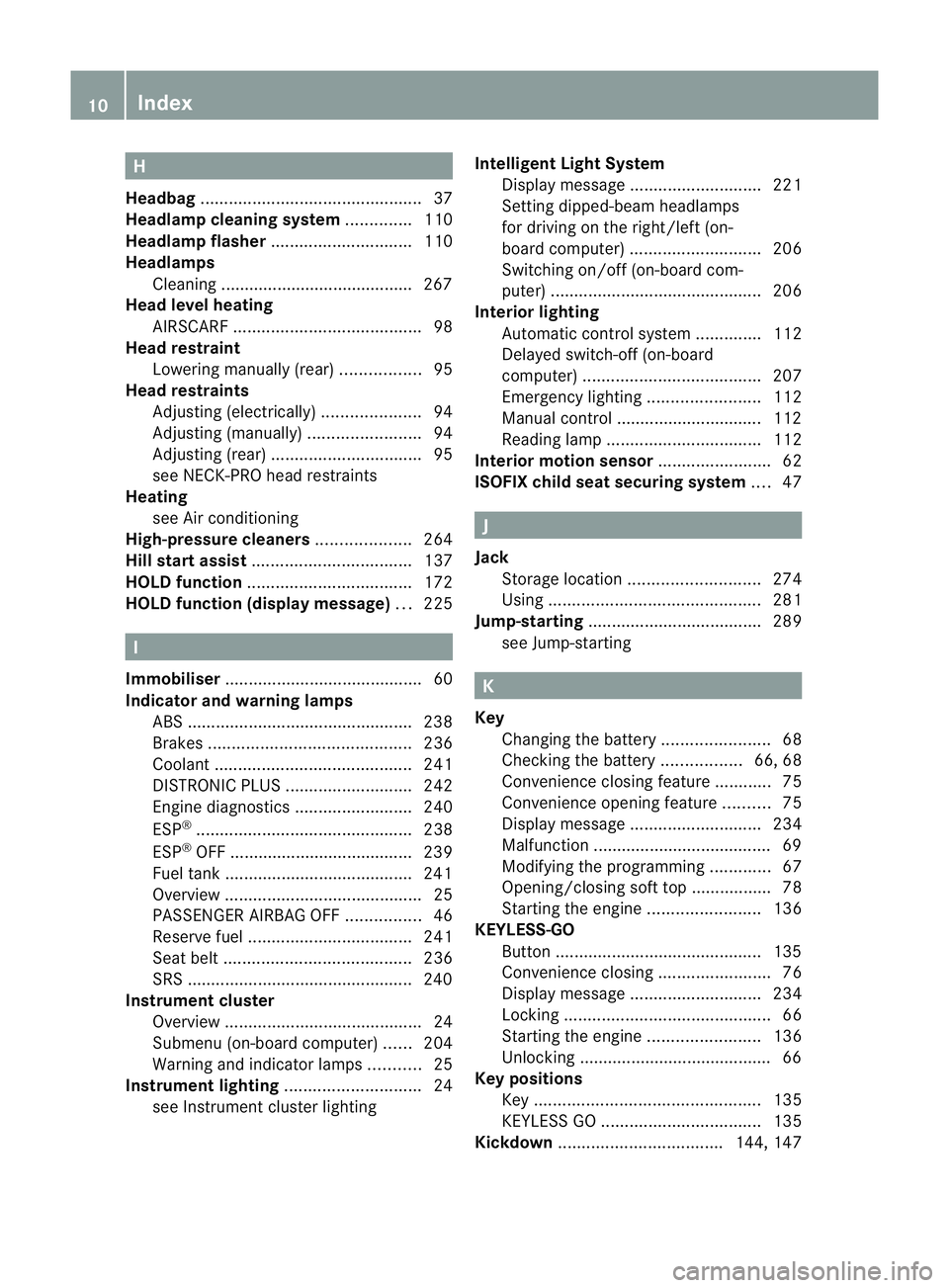
H
Headbag ............................................... 37
Headlamp clean ings yst em .............. 110
Headlamp flasher .............................. 110
Headlamps Clean ing. ........................................ 267
Head level heating
AIRSCAR F........................................ 98
Head restraint
Lowering manually (re ar)................. 95
Head restraints
Adjusting (e lectrically )..................... 94
Adjusting (manually )........................ 94
Adjusting (re ar)................................ 95
se eN ECK-PR Ohead restraints
Hea ting
see Air conditioning
High-pressu recleaners .................... 264
Hill star tassist .................................. 137
HOLD function ................................... 172
HOLD functio n(display message) ...225 I
Immobili ser.......................................... 60
Ind icator and warn ingl amps
ABS ................................................ 238
Brake s........................................... 236
Co olan t.......................................... 241
DISTRONI CPLUS ........................... 242
Engine di agnostics ......................... 240
ESP ®
.............................................. 238
ESP ®
OFF ....................................... 239
Fue ltank ........................................ 241
Overview .......................................... 25
PASSENGER AIRBAG OFF ................46
Reserve fuel ................................... 241
Sea tbelt. ....................................... 236
SRS ................................................ 240
Instrument cluster
Overview .......................................... 24
Submenu (on-bo ardc omputer )...... 204
Warn inga nd indicator lamps ...........25
Instrument li ghting ............................. 24
se eI nstrument cluster lighting Intelligen
tLight System
Display message ............................ 221
Setting di pped-beam headlamps
for driving on the right/left (on-
board computer) ............................ 206
Switch ingo n/off (on-board com-
puter) ............................................. 206
Int erior lighting
Automatic control system ..............112
Del ayed swit ch-off (on-bo ard
computer) ...................................... 207
Emergency lighting ........................112
Manual control ............................... 112
Reading lamp ................................. 112
Int erior motion sensor ........................62
IS OFIX child seat securing system ....47 J
Jack Storage locatio n............................ 274
Using ............................................. 281
Jump-starting ..................................... 289
se eJ ump-st arting K
Key Changing the battery .......................68
Ch ecking the battery .................66, 68
Convenience closing feat ure. ........... 75
Convenience op ening feature ..........75
Display message ............................ 234
Ma lfunction ...... ................................ 69
Modifying the programming .............67
Opening/closing soft top .................78
Starting the engine ........................136
KEYLES S-GO
Button ............................................ 135
Convenience closing ........................76
Display message ............................ 234
Locking ............................................ 66
Starting the engine ........................136
Unlockin g......................................... 66
Ke yp ositions
Key ................................................ 135
KEYLESS GO .................................. 135
Kickdown ................................... 144, 14710
Index BA 207 ECE ÄJ 2010/1a; 1; 2, en-GB
mkalafa
Version: 3.0.2.11 2010-01-26T13:03:22+01:00-Seite 10
Page 73 of 333
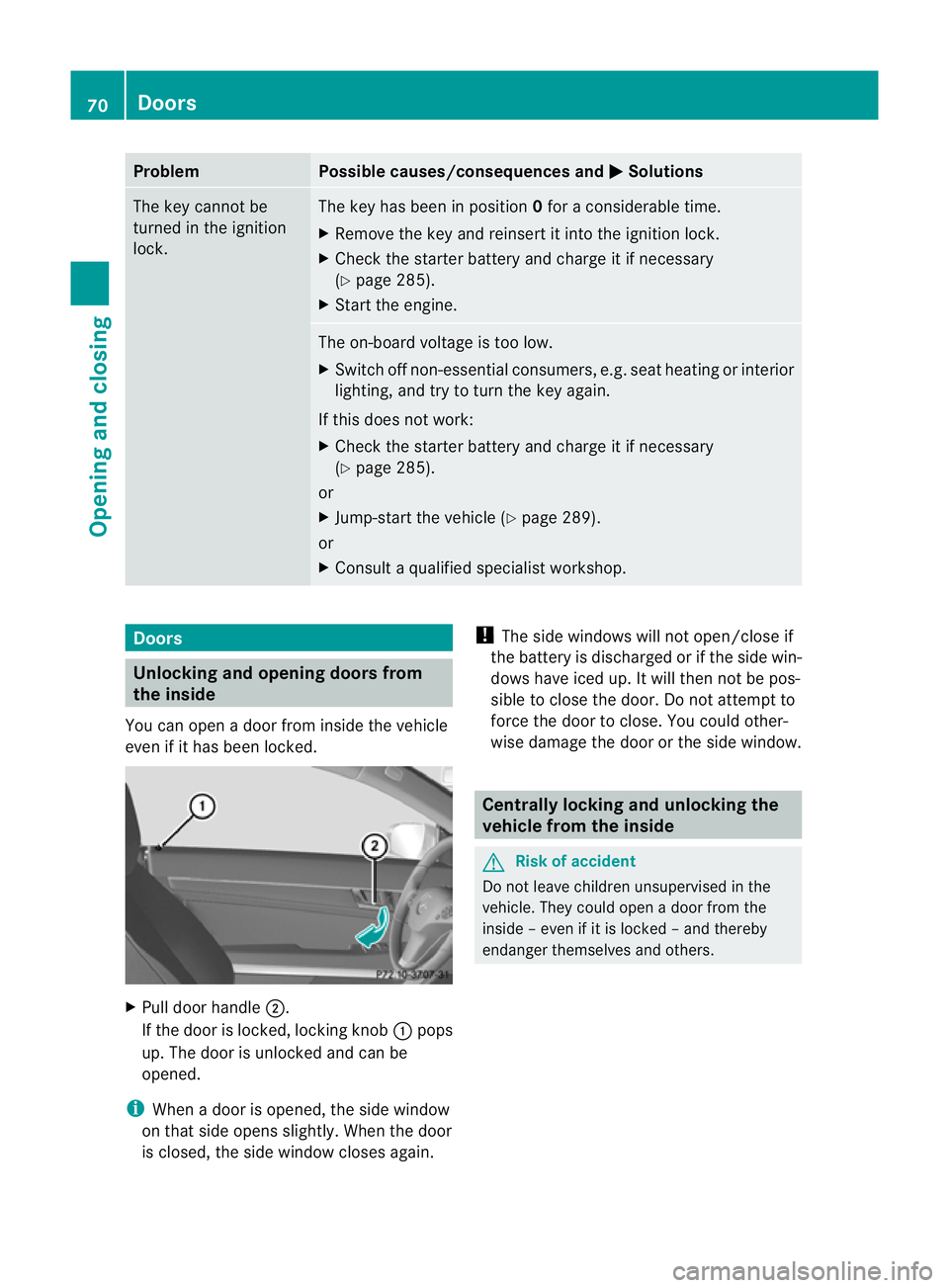
Problem Possible causes/consequences and
M Solutions
The key cannot be
turned in the ignition
lock. The key has been in position
0for aconsiderable time.
X Remove the key and reinsert it int othe ignition lock.
X Chec kthe starter battery and charge it if necessary
(Y page 285).
X Star tthe engine. The on-boar
dvoltage is too low.
X Switch off non-essential consumers, e.g. seat heatin gorinterior
lighting ,and try to turn the key again.
If this doe snot work:
X Check the starter battery and charge it if necessary
(Y page 285).
or
X Jump-start the vehicle (Y page 289).
or
X Consult aqualified specialist workshop. Doors
Unlocking and opening doors from
the inside
You can open adoor from inside the vehicle
even if it has been locked. X
Pull door handle ;.
If the door is locked, locking knob :pops
up. The door is unlocked and can be
opened.
i When adoor is opened, the side window
on that side opens slightly .When the door
is closed ,the side window closes again. !
The side windows will not open/close if
the battery is discharged or if the side win-
dows hav eiced up. It wil lthen not be pos-
sible to close the door. Do not attemp tto
force th edoor to close. You coul dother-
wise damage the doo rorthe side window. Centrally locking and unlocking the
vehicle from th einside G
Risk of accident
Do not leav echildren unsupervised in the
vehicle. They coul dopen adoor from the
inside –even if it is locke d–and thereby
endanger themselves and others. 70
DoorsOpening and closing
BA 207 ECE ÄJ 2010/1a; 1; 2, en-GB
mkalafa
Version: 3.0.2.11 2010-01-26T13:03:22+01:00-Seite 70
Page 143 of 333

Problems wit
hthe engine Problem Possible causes/consequences and
M Solutions
Th
ee ngine doe snot
start. The HOL
Dfunction or DISTRONIC PLUS is activated.
X Deactivat ethe HOL Dfunction (Y page 172)orDISTRONIC
PLUS (Y page 160).
X Try to start th eengine again. The engine doe
snot
start. The starter motor
can be heard. R
There is amalfunction in the engine electronics.
R There is amalfunction in the fuel supply.
R The on-board voltage is too low because the starter battery is
too weak or discharged.
X Before attempting to start the engine again, turn the key in the
ignition back to position 0or press the Start/Stop button
repeatedly until all indicator lamps in the instrumen tcluster go
out.
X Try to star tthe engin eagain (Y page 136). Avoid excessively
long and frequen tattempt stostart the engine as thes ewill drain
the battery.
If the engine does not start after several attempts:
X Consult aqualified specialist workshop. The engine does not
start
.The starter motor
can be heard. The
reserve fuel warning
lam pisl it and the fuel
gauge displa yshows 0. The fuel tan
kise mpty.
X Refue lthe vehicle. The engin
edoes not
start. You cannot hear
the starter motor. The on-boar
dvoltage is too low because the starter battery is too
weak or discharged.
X Jump-start the vehicle (Y page 289).
If the engin edoes not star tdespite attempt stojump-start it:
X Consult aqualified specialist workshop. The starter motor was exposed to
athermal load that was too high.
X Allo wthe starter motor to cool down for approximatel ytwo
minutes.
X Try to start the engine again.
If the engine still does not start:
X Consult aqualified specialist workshop. 140
DrivingDrivin
gand pa rking
BA 20 7ECE ÄJ 2010 /1a;1;2,e n-GB
mkalafa Version: 3.0.2.11 2010-01-26T13:03:22+01:00-Seite 140
Page 274 of 333
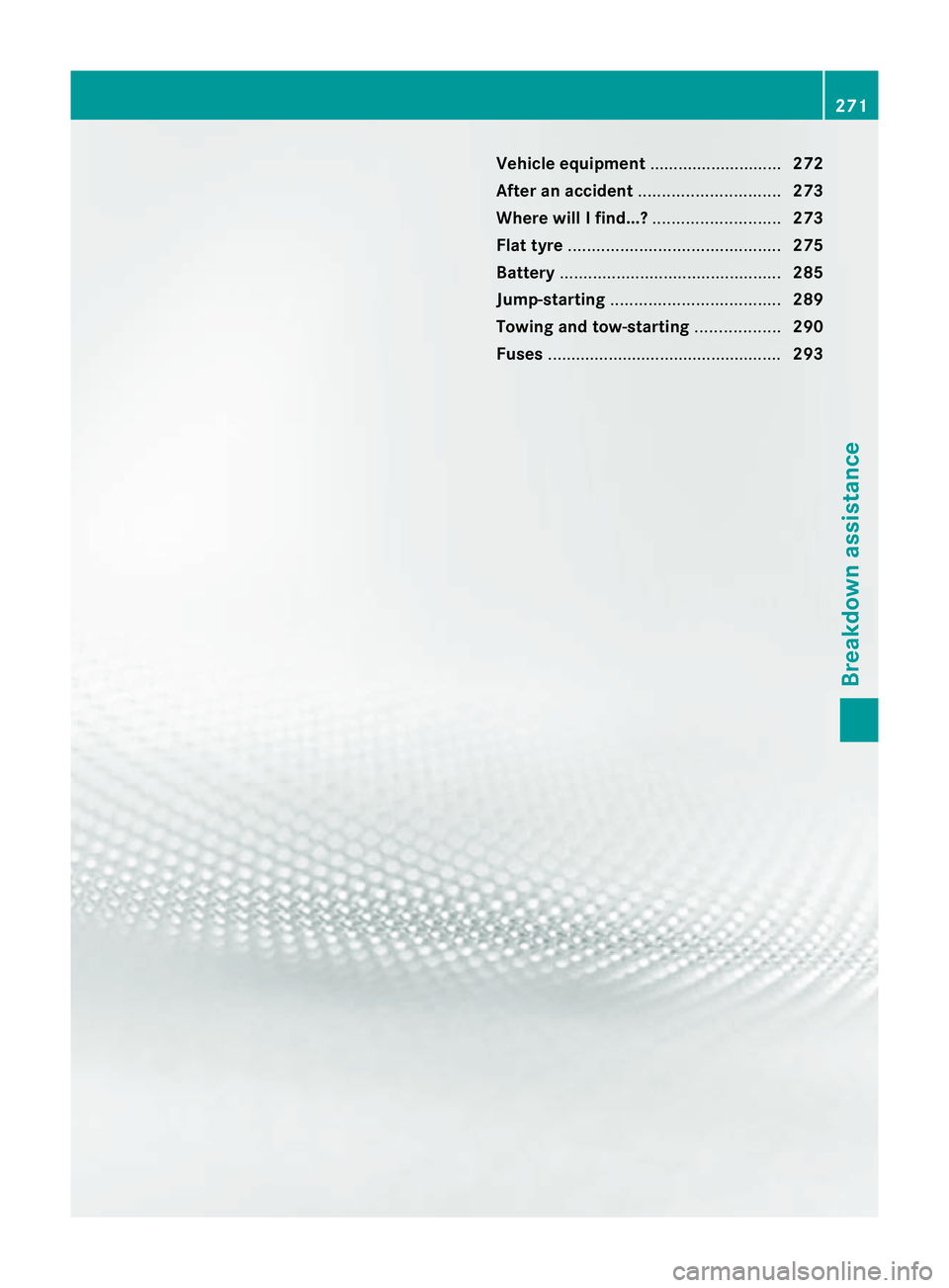
Vehicl
eequipment ............................ 272
After an accident .............................. 273
Wher ewillIfind...? ........................... 273
Flat ty re............................................. 275
Ba ttery ............................................... 285
Jump-starting .................................... 289
Towing and tow-starting ..................290
Fuses .................................................. 293 271Break
down assistance
BA 20 7ECE ÄJ 2010/1a; 1; 2, en-GB
mkalafa Version:3.0.2.11
2010-01-26T13:03:22+01:0
0-Seite 271
Page 290 of 333

R
the brake boosting effect will not be avail-
able .Greater braking force wil lthen be
required and brake pedal travel will be lon-
ger. If necessar y,depress the brak epedal
with maximum force.
R the transmission is locked in position Pon
vehicles with automati ctransmission.
! Alwaysd isconnect the battery in the
order described below. Never mix up the
terminal clam pdisconnection/connection
order and never mix up the terminal
clam ps.You may otherwis edamag ethe
vehicle electronics. :
Battery
; Positive terminal
= Negativ eterminal
? Breather hose
X Remove the negative terminal clam pfrom
th eb attery.
X Remove the cover from the positive termi-
nal clamp.
X Remove the positive terminal clamp from
the battery.
X Disconnect the breather hose. Fittin
gand removin gthe battery
X To remove: disconnect th ebattery
(Y pag e286).
X Loose nthe bolt which holds the battery in
place. X
Rem ovet he battery.
X To fit: follow the steps described in "To
remove" in reverse order. Charging th
ebattery G
Ris
kofi njury
Only charge the batter yinawell-ventilated
area. As the battery is being charged ,gases
can escape and generate minor explosions.
This could injure you and other persons or
cause damage to the paintwork or acid cor-
rosion on the vehicle.
You can obtain information about battery
chargers which allow the battery to be
charged while still installed from aqualified
specialist workshop ,e.g. aM ercedes-Benz
Ser vice Centre. G
Risk of injury
There is arisk of acid burns during the charg-
ing process due to the gases which escape
from the battery. Do not lean over the battery
during the chargin gprocess. G
Ris
kofi njury
Bat tery aci discaustic. Avoid contact with the
skin, eyes or clothing.
! Only charge the installed batter ywith a
batter ycharger whic hhas been tested and
approved by Mercedes -Benz .These battery
chargers allow the battery to be charged
while still installed.
! Only use battery chargers with amaxi-
mum charging voltage of 14.8 V.
! Only charge the battery using the jump-
start connection point.
The jump-starting connection point is in the
engine compartmen t(Ypage 289).
X Open the bonnet (Y page 259).
X Connec tthe battery charger to the positive
terminal and earth point in the sam eorder Battery
287Breakdown assistance
BA 207 ECE ÄJ 2010/1a; 1; 2, en-GB
mkalafa Version: 3.0.2.11 2010-01-26T13:03:22+01:00-Seite 287 Z
Page 291 of 333
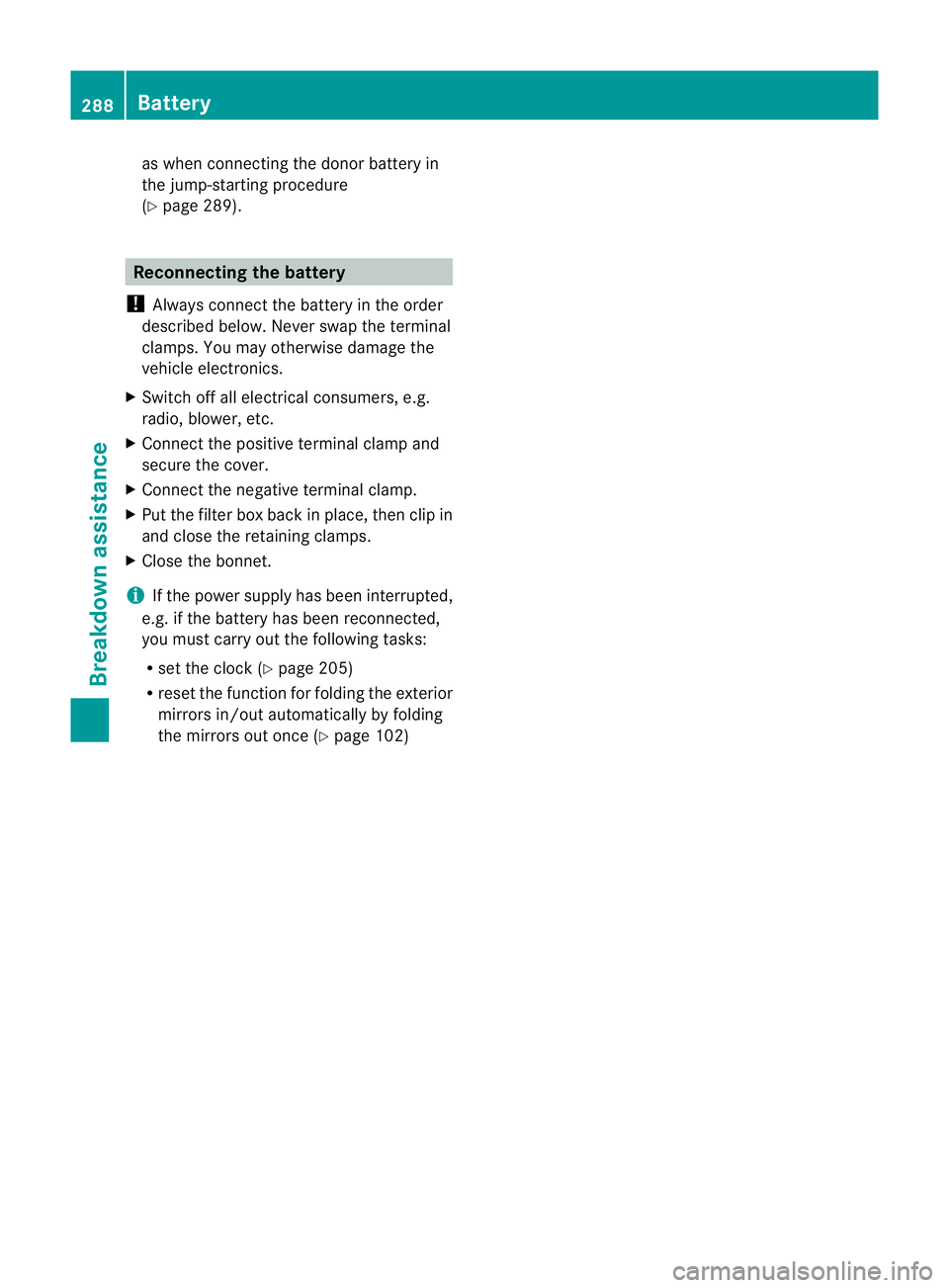
as when con
necting the do norb atter yin
the jump-starting procedure
(Y page 289). Reconnecting th
ebattery
! Always connect the battery in the order
described below. Never swap the terminal
clamps. Yo umay otherwise damage the
vehicle elect ronics.
X Switch off all ele ctrical consumers, e.g.
radio, blower, etc.
X Connect the positiv eterminal clamp and
secur ethe cov er.
X Connect th enegative termina lclamp.
X Put th efilter box back in place, then clip in
and close th eretaining clamps.
X Close th ebonnet.
i If th epower supply has been interrupted,
e.g .ift he battery has been reconnected,
you must carry out the followin gtasks:
R set the clock (Y page 205)
R reset the function for folding the exterior
mirrors in/out automatically by folding
the mirrors out once (Y page 102)288
BatteryBreakdown assistance
BA 207 ECE ÄJ 2010/1a; 1; 2, en-GB
mkalafa
Version:3.0.2.11
2010-01-26T13:03:22+01:00
-Seite 288
Page 292 of 333
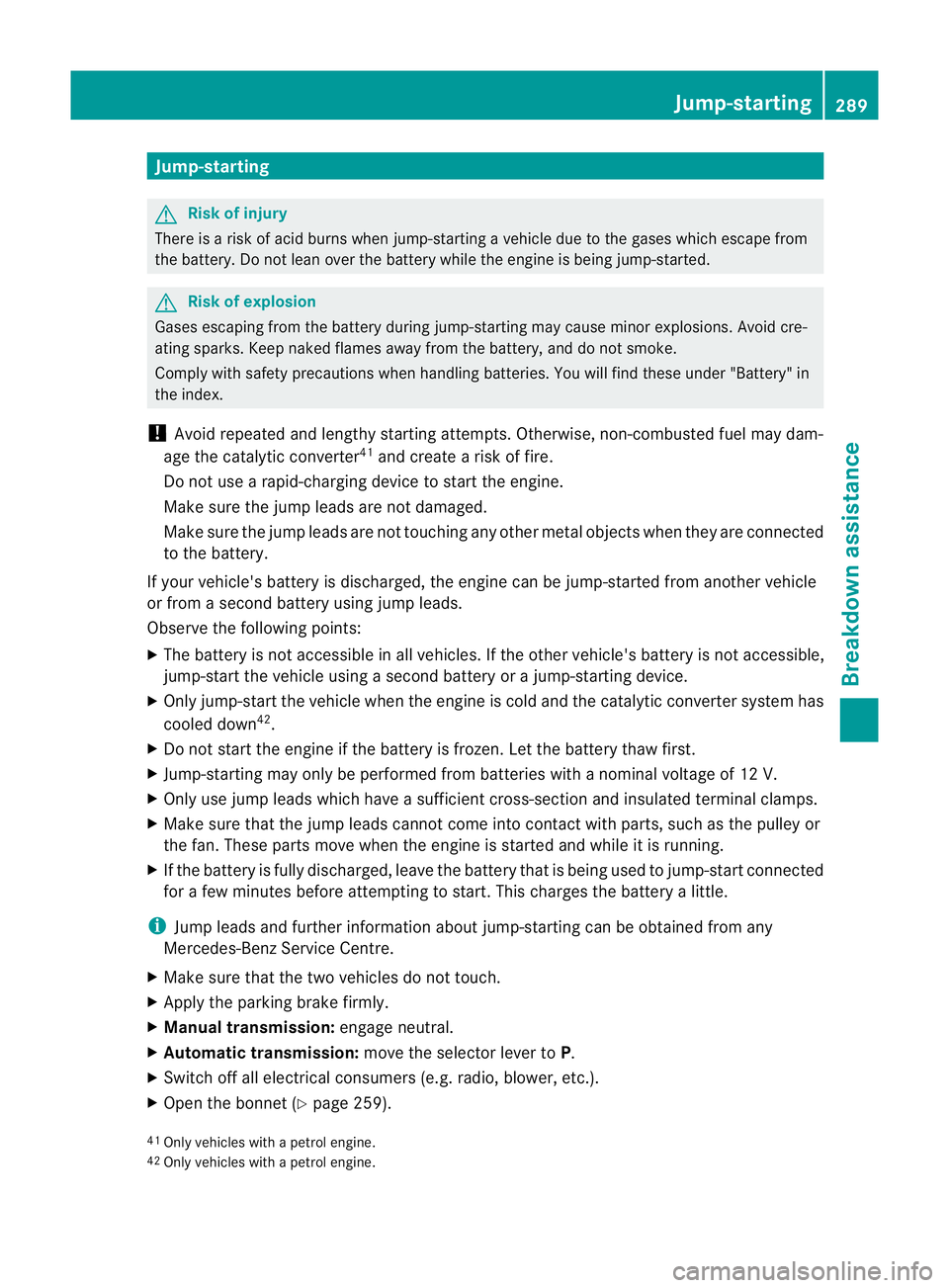
Jum
p-starting G
Risk of injury
There is arisk of acid burns when jump-starting avehicle due to the gases which escape from
the battery. Do not lean over the batter ywhile the engin eisbeing jump-started. G
Risk of explosion
Gases escapin gfrom th ebattery during jump-starting may cause minor explosions. Avoid cre-
ating sparks. Keep naked flames away from the battery, and do not smoke.
Comply with safety precautions when handling batteries. You will find these under "Battery" in
the index.
! Avoid repeated and lengthy startin gattempts. Otherwise, non-combuste dfuel may dam-
age the catalytic converter 41
and create arisk of fire.
Do not use arapid-charging device to start the engine.
Make sure the jump leads are not damaged.
Make sure the jump leads are not touching any other metal objects when they are connected
to the battery.
If your vehicle's battery is discharged ,the engin ecan be jump-started from another vehicle
or from asecond batter yusing jum pleads.
Observ ethe followin gpoints:
X The battery is not accessible in all vehicles. If the other vehicle' sbattery is not accessible,
jump-start the vehicle using asecond batter yorajump-star ting device.
X Only jump-start the vehicl ewhen th eengineisc old an dthe catalytic converter system has
cooled down 42
.
X Do no tstart the engine if the battery is frozen. Let the battery thaw first.
X Jump-starting may only be performed from batterie swithanominal voltage of 12 V.
X Only use jum pleads which have asufficient cross-section and insulated terminal clamps.
X Make sure that the jump leads cannot come into contact with parts, such as the pulley or
the fan. Thes eparts move when the engine is started and while it is running.
X If the battery is fully discharged ,leave the batter ythat is being used to jump-star tconnected
for afew minutes befor eattempting to start. This charges the battery alittle.
i Jump leads and further information about jump-startin gcan be obtained from any
Mercedes-Ben zService Centre.
X Make sure that the two vehicles do not touch.
X Apply the parking brak efirmly.
X Manual transmission: engage neutral.
X Automatic transmission: move the selector lever toP.
X Switch off all electrical consumer s(e.g. radio, blower, etc.).
X Open the bonnet (Y page 259).
41 Only vehicles with apetrol engine.
42 Only vehicles with apetrol engine. Jump-starting
289Breakdown assistance
BA 207ECE ÄJ 2010 /1a;1;2,e n-GB
mkalafa Version: 3.0.2.11 2010-01-26T13:03:22+01:00-Seite 289 Z
Page 293 of 333

Position number
Bidentifie sthe charged batter yofthe other vehicle or an equivalen tjump-
starting device.
X Slide cover :of positive terminal ;in the direction of the arrow.
X Connec tpositiv eterminal ;on your vehicle to positiv eterminal =of donor battery B
using the jum plead, beginning with your own battery.
X Start the engine of the donor vehicle and run it at idling speed.
X Connect negative terminal ?of donor battery Bto eart hpoint Aof your vehicle using
the jum plead, connectin gthe jum plead to donor battery Bfirst.
X Start the engine.
X First remove the jum plead from eart hpoint Aand negative terminal ?,then from positive
terminal ;and positive terminal =,each time disconnecting from the battery on your own
vehicle first.
X Have the battery checked at aqualified specialist workshop, e.g. aMercedes-Ben zService
Cent re. Towin
gand tow-star ting Important safet
ynotes
When towing, observe the legal requirements
in all countries concerned. G
Risk of accident
If you tow the vehicle, you must use arigid
towing bar if: R
the engin eisnot run ning.
R there is abrake system malfunction.
R there is amalfunction in the voltage supply
or the vehicle's electrical system.
The power steering and the brake forc eboos-
ter do not work when the engin eisnot run-
nin g. Yo uwill then need considerably more
forc etos teer and to brake and the brake
peda ltrave lwill be longer. If necessary,
depress the brake pedal with maximum force. 290
Towing and tow-startingBreakdown assistance
BA 207 ECE ÄJ 2010/1a; 1; 2, en-GB
mkalafa
Version: 3.0.2.11
2010-01-26T13:03:22+01:00
-Seite 290
Page 294 of 333

Befor
etowing away ,make sur ethat the steer-
ing can be mov edand is not locked.
If yo utow or tow- start another vehicle, its
weigh tmustn ot excee dthe maximum per-
missible gross vehicle weigh tofyour vehicle. G
Risk of accident
The vehicle is braked when the HOL Dfunction
or DISTRONIC PLUS is activated. Therefore,
deactivate HOLD and DISTRONIC PLUS if the
vehicle is to be towed.
It is better to have the vehicle transported
than to have it towed.
! Whe ntowing, pull away slowly and
smoothly. If the tractive power is too high,
the vehicles coul dbedamaged.
! Do not use the towing eye for recovery,
as this could damage the vehicle. If in
doubt, recover the vehicle with acrane.
! Youm ay tow the vehicle for amaximum
of 50 km. Atowing speed of 50 km /h must
no tbee xceeded.
For towing distances over 50 km, the entire
vehicl emust be lifted up and transported.
! On vehicles with KEYLESS-GO, use the
key instead of the Start/Stop button .Turn
the key to position 2in the ignition lock and
shif tthe automatic transmission to N.
Then, turn the key back to 0and leave it in
the ignitio nlock.
! Only secur ethe tow cable or towing bar
to the towing eyes. You could otherwise
damage the vehicle.
Please note:
R vehicles with an automatic transmission
must not be tow-started.
R if you ar etowing the vehicle over alonger
distance, this must be done with the rear
axle raised.
R the ignition must be switched off if you are
towin gthe vehicle with the rea raxle raised. Intervention by ESP
®
could otherwis edam-
age the brake system.
R if the vehicle has suffered transmission
damage, only tow it with the propelle rshaft
disconnected.
R if the engin edoes not start, tr yjump-start-
ing it (Y page 289).
R if it is not possible to jump-start the vehicle,
have it towed to the nearest qualified spe-
cialist workshop, e.g. aMercedes-Benz
Servic eCentre.
R the automatic transmission must be in
position Nwhen the vehicle is being towed.
Before towing the vehicle, mak esure that the
battery is connected and charged. You will
otherwis ebeunable to switch on the ignition
or shift the transmissio ntoNin vehicles with
an automatic transmission.
i Switch off the automatic locking feature
before the vehicle is towed (Y page 208).
You could otherwise be locked out when
pushing or towing the vehicle. Fitting the towing eye
Vehicles with atrailer to whitch: if you intend
to use the vehicle for towing, fold out the ball
coupling and connect the towbar to it
(Y page 186).
X Take the towing eye and the wheel wrench
from the vehicle tool kit (Y page 274).
The mountings for the removable towing eyes
are located in the bumpers. They are at the
front and at the rear ,under the covers. Towing and tow-starting
291Breakdown assistance
BA 207 ECE ÄJ 2010/1a;1;2,e n-GB
mkalafa Version: 3.0.2.11 2010-01-26T13:03:22+01:00-Seite 291 Z